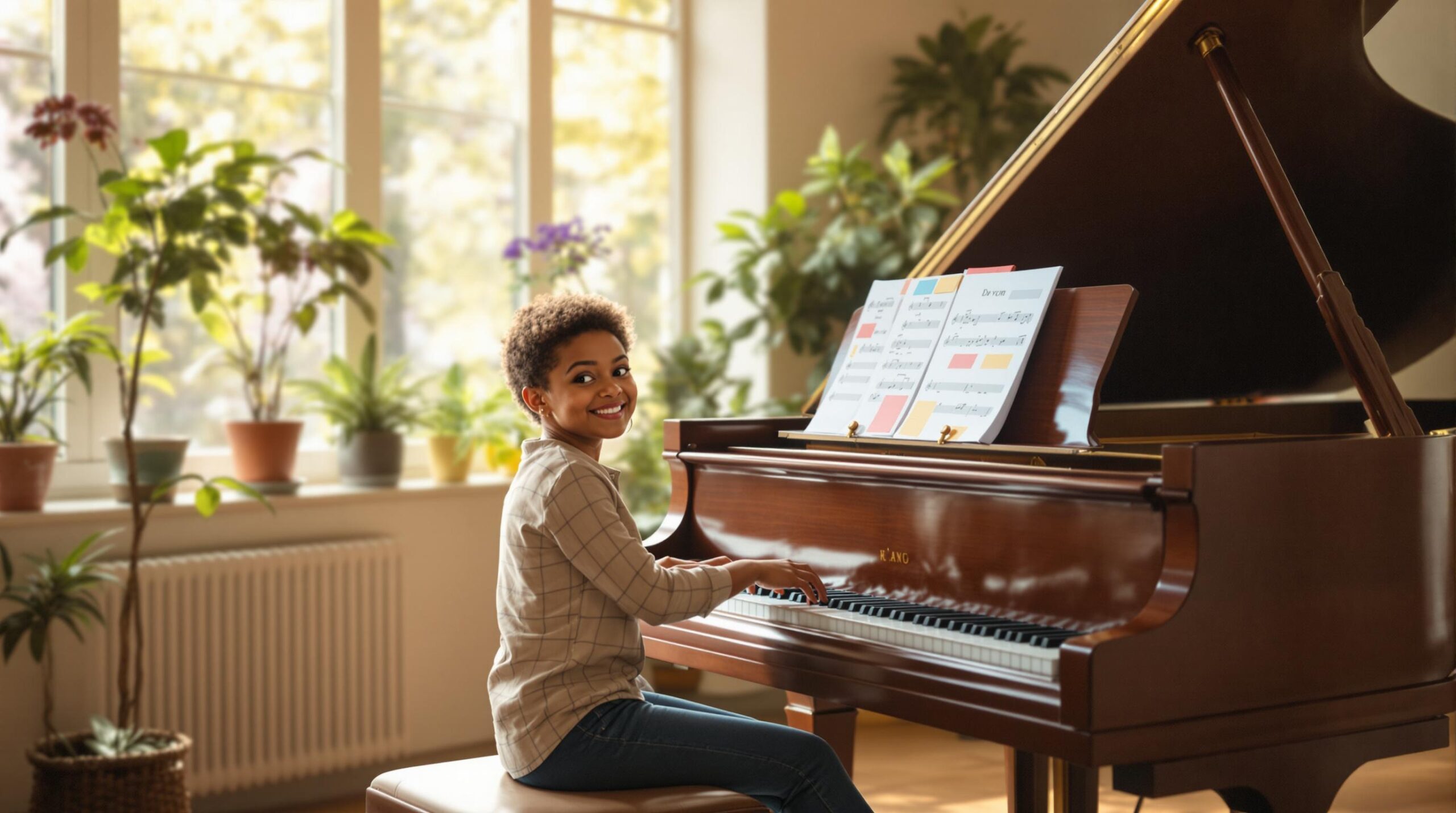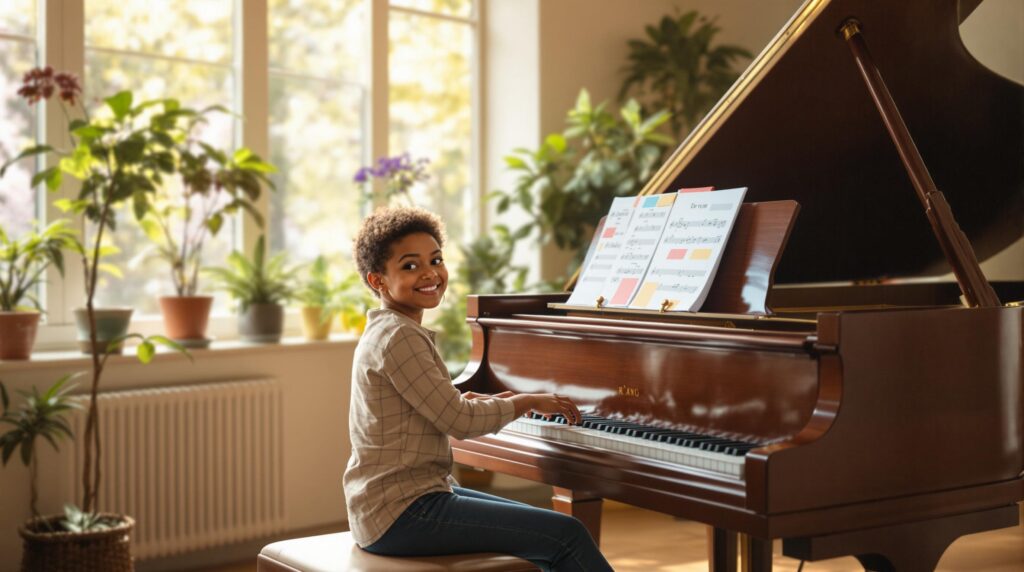
Trust is the foundation of effective piano teaching. It helps students feel safe, stay motivated, and grow musically. Here are five straightforward ways piano teachers can build trust with their students:
- Create a welcoming learning space: Design a comfortable, organized studio with proper lighting, good acoustics, and a well-maintained piano.
- Communicate openly: Set clear expectations, provide specific feedback, and encourage two-way conversations.
- Demonstrate expertise: Showcase your skills through live examples, share your teaching background, and stay updated on modern techniques.
- Personalize lessons: Adapt lessons to match each student’s goals and pace for a more engaging experience.
- Track and celebrate progress: Use tools to monitor improvement and recognize milestones with certificates, recitals, or feedback.
These steps create a supportive environment where students feel encouraged to explore their musical potential.
8 Tips for Piano Teachers
1. Set Up a Comfortable Learning Space
Creating a welcoming and professional piano studio is key to helping students feel comfortable and focused during lessons. A well-designed space can make all the difference in their learning experience.
Use natural light for daytime lessons and switch to warm LED lighting in the evening to minimize eye strain when reading sheet music. Thoughtful lighting choices set the tone for a productive and enjoyable studio environment.
Key elements to include in your studio:
- A well-maintained piano positioned away from direct sunlight and heat to protect it.
- An adjustable bench to ensure proper posture for students.
- Ample space for movement and comfortable seating.
- Good ventilation with a stable temperature to keep the room comfortable.
- Sound-absorbing materials to improve acoustics and reduce distractions.
To keep your piano in top condition, work with reliable providers like Cooper Piano. A well-maintained instrument reinforces the studio’s professional feel.
Stay organized by storing sheet music and other materials in shelves or cabinets. Add a personal touch with framed sheet music, awards, or a display of student achievements – but keep the overall look clean and professional.
Make sure there’s a clear line of sight between you and your student for easy demonstrations. If you teach at home, keep your studio separate from living areas, and consider setting up a small waiting area to signal the start of lessons.
A carefully planned space not only encourages learning but also helps build the trust that’s so important for effective piano lessons.
2. Use Direct, Open Communication
Open and clear communication is key to building trust between piano teachers and students. Start each lesson by outlining expectations – covering practice routines, lesson structure, and learning goals. This clarity helps set the tone for a productive relationship.
When offering feedback, aim to be specific and actionable. For instance, instead of vague comments, address exact areas for improvement: "In measures 8–12, the rhythm feels rushed – try slowing down the tempo to refine it."
Here are a few strategies to improve communication and connect with students:
- Active listening: Give your full attention, maintain eye contact, and acknowledge their concerns.
- Positive reinforcement: Balance critiques with genuine praise. Highlight specific progress, like: "Your relaxed hand position is really improving the flow of your legato passages."
- Regular updates: End each lesson with a quick summary of what went well and what to focus on during practice.
Encourage a two-way conversation by inviting questions and checking for understanding. Asking students to restate concepts can reveal any confusion and show you value their input.
When discussing practice routines, be clear and realistic:
- Break weekly goals into daily tasks.
- Specify which sections need attention.
- Suggest specific practice times (e.g., 20–30 minutes daily).
- Provide written notes for easy reference.
Adjust your teaching approach to fit the student’s age and learning style. Younger students often benefit from visual aids and simple instructions, while adults may prefer detailed explanations and context about the music.
Finally, track progress in a notebook or digital tool to keep everyone on the same page. This structured communication works hand-in-hand with a well-organized learning environment.
sbb-itb-b8bc1ab
3. Show Musical Knowledge and Skills
Demonstrating your musical expertise during lessons helps establish trust and credibility with students. It reassures them that they’re learning from a skilled and knowledgeable teacher.
Start each lesson by playing the piece the student is learning. This live demonstration highlights proper technique, hand positioning, finger movements, pedaling, and sight-reading. Use this opportunity to explain important concepts like articulation and phrasing. For example, while teaching Bach’s "Minuet in G," point out common mistakes and how to avoid them.
Share a bit about your background – your performance experience, education, and teaching history. This adds a personal touch and helps connect your expertise to the lesson. When introducing new ideas, tie them to real-world examples. For instance, when teaching scales, show how they appear in well-known pieces and explain their role in building finger strength.
Make technical concepts approachable. If a student struggles with rhythm, play a passage both correctly and incorrectly to highlight the difference and guide them toward proper execution.
Keep your skills sharp by participating in:
- Workshops and seminars
- Professional organizations
- Learning modern teaching techniques
- Exploring contemporary music
Organize student recitals and include your own performances. This not only showcases your skills but also demonstrates your dedication to ongoing growth. You can also record and share your performances as proof of your active engagement in music.
Maintain a portfolio that includes:
- Academic credentials
- Records of student achievements
- Performance videos
- Details of professional development
This visible commitment to your craft underscores the importance of piano education and inspires students to pursue their own musical goals.
4. Match Lessons to Student Goals
After establishing clear communication and demonstrating expertise, the next step is aligning lessons with what your students want to achieve. This approach helps strengthen trust and keeps them engaged.
Adjust the lesson pace to fit each student’s learning style. Start by assessing how well they understand new concepts during the first session. Then, shape the lessons to suit their individual needs.
Here’s how to adapt your teaching:
- For quicker learners, introduce more advanced topics and offer additional challenges.
- For those who need more time, break down tough concepts into smaller, easier-to-follow steps.
This personalized approach ensures every student feels supported and motivated.
5. Track and Reward Progress
Keeping an eye on progress and celebrating milestones boosts confidence and strengthens trust. A digital tracker can help log weekly skills, completed pieces, and technical improvements, offering a clear picture of growth over time.
Here are some practical ways to acknowledge progress:
- Monthly Performance Sessions: Host informal mini-recitals where students can perform in a relaxed, supportive setting. These short, 15-minute showcases help build confidence ahead of larger performances.
-
Achievement Certificates: Design personalized certificates for accomplishments like:
- Learning five new pieces
- Mastering a tough technique
- Maintaining a consistent practice routine
- Completing a theory test
-
Progress Reports: Share monthly updates that cover:
- Technique improvements
- Repertoire growth
- Practice consistency
- Areas needing attention
Small wins matter. Whether a student conquers a tricky passage or nails a new skill, recognize their effort. This kind of positive feedback not only reinforces their trust in your teaching but also keeps their motivation high.
For younger students, try sticker charts or digital badges to make progress fun. Older students often appreciate detailed feedback and performance comparisons.
To keep parents in the loop, send brief updates via email. This regular communication strengthens trust with families and ensures everyone stays aligned with the student’s goals.
Conclusion
Building trust in piano lessons lays the groundwork for meaningful musical growth and success. By creating welcoming environments, keeping communication open, showcasing expertise, tailoring lessons to individual needs, and celebrating achievements, teachers can help boost students’ confidence and motivation. These combined efforts improve performance while also strengthening the teacher’s role.
Educators can also turn to reliable partners like Cooper Piano to ensure access to quality instruments, which are essential for effective teaching and learning.
When applied consistently, these strategies cultivate a space where students feel supported and inspired to chase their musical goals. Beyond technical skills, this connection can spark a lifelong love for music.

